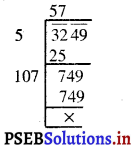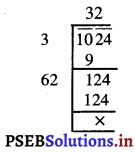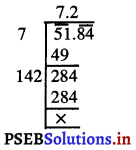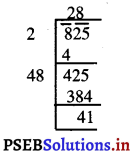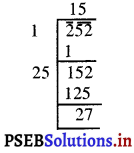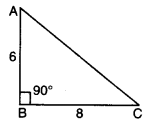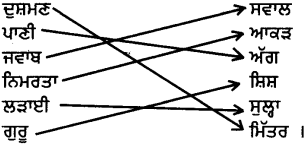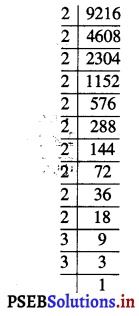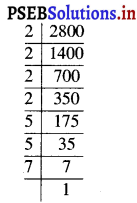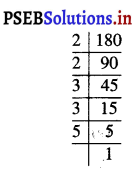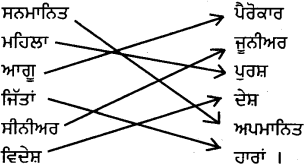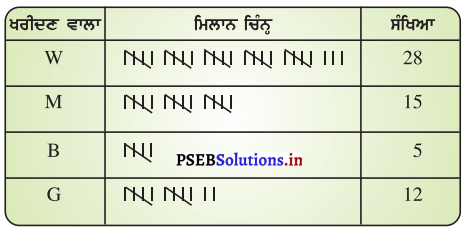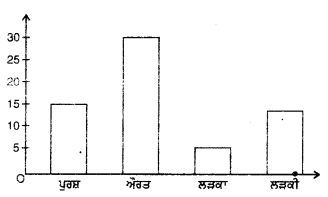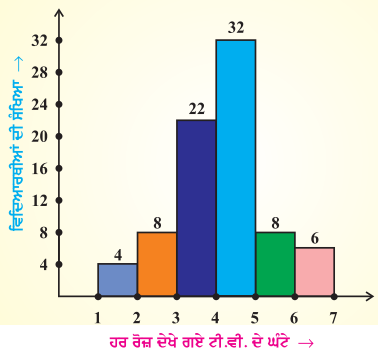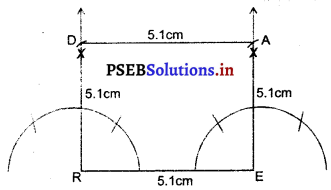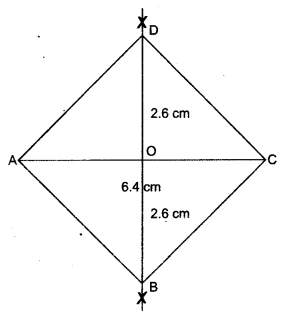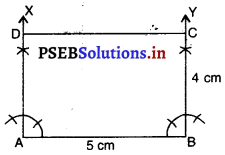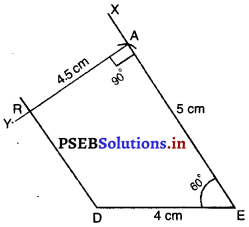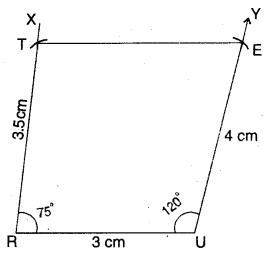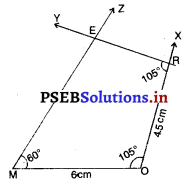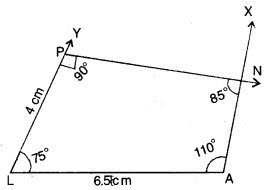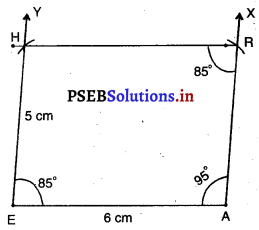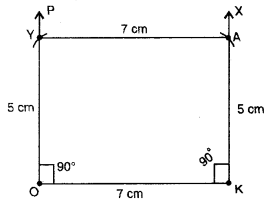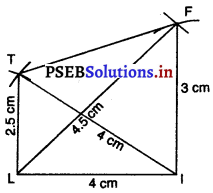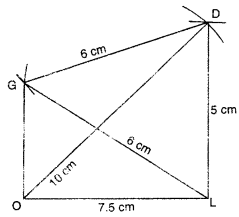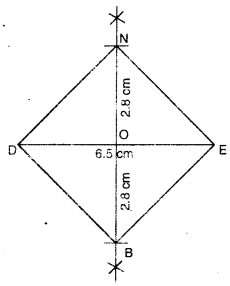Punjab State Board PSEB 8th Class Maths Book Solutions Chapter 6 ਵਰਗ ਅਤੇ ਵਰਗਮੂਲ InText Questions and Answers.
PSEB 8th Class Maths Solutions Chapter 6 ਵਰਗ ਅਤੇ ਵਰਗਮੂਲ InText Questions
ਕੋਸ਼ਿਸ਼ ਕਰੋ :
ਪ੍ਰਸ਼ਨ 1.
ਦਿੱਤੀਆਂ ਗਈਆਂ ਸੰਖਿਆਵਾਂ ਦੇ ਵਿਚ ਮੌਜੂਦ ਪੂਰਨ ਵਰਗ ਸੰਖਿਆਵਾਂ ਪਤਾ ਕਰੋ ।
(i) 30 ਅਤੇ 40
(ii) 50 ਅਤੇ 60.
ਹੱਲ:
(i) 30 ਅਤੇ 40 ਦੇ ਵਿਚ ਸੰਖਿਆ 36 ਪੂਰਨ ਵਰਗ ਸੰਖਿਆ ਹੈ ।
(ii) 50 ਅਤੇ 60 ਵਿਚ ਕੋਈ ਵੀ ਪੂਰਨ ਵਰਗ ਸੰਖਿਆ ਨਹੀਂ ਹੈ ।
ਕੋਸ਼ਿਸ਼ ਕਰੋ :
ਪ੍ਰਸ਼ਨ 1.
ਕੀ ਅਸੀਂ ਕਹਿ ਸਕਦੇ ਹਾਂ ਕਿ ਹੇਠ ਲਿਖੀਆਂ ਸੰਖਿਆਵਾਂ ਪੂਰਨ ਵਰਗ ਸੰਖਿਆਵਾਂ ਹਨ ? ਅਸੀਂ ਕਿਸ ਤਰ੍ਹਾਂ ਜਾਣਦੇ ਹਾਂ ?
(i) 1057
(ii) 23453
(iii) 7928
(iv) 222222
(v) 1069
(vi) 2061.
ਹੱਲ:
(i) 1057
1057 ਵਿਚ 7 ਇਸਦਾ ਇਕਾਈ ਦਾ ਅੰਕ ਹੈ ।
∴ 1057 ਪੂਰਨ ਵਰਗ ਨਹੀਂ ਹੈ ।
(ii) 23453
23453 ਵਿਚ 3 ਇਸਦਾ ਇਕਾਈ ਅੰਕ ਹੈ ।
∴ 23453 ਪੁਨ ਵਰਗ ਸੰਖਿਆ ਨਹੀਂ ਹੈ ।
(iii) 7928
7928 ਵਿਚ 8 ਇਸਦਾ ਇਕਾਈ ਦਾ ਅੰਕ ਹੈ ।
∴ 7928 ਪੂਰਨ ਵਰਗ ਸੰਖਿਆ ਨਹੀਂ ਹੈ ।
(iv) 222222
222222 ਵਿਚ 2 ਇਸਦਾ ਇਕਾਈ ਦਾ ਅੰਕ ਹੈ ।
∴ 222222 ਪੂਰਨ ਵਰਗ ਸੰਖਿਆ ਨਹੀਂ ਹੈ ।
(v) 1069 ਪੂਰਨ ਵਰਗ ਸੰਖਿਆ ਨਹੀਂ ਹੈ ।
(vi) 2061 ਪੂਰਨ ਵਰਗ ਸੰਖਿਆ ਨਹੀਂ ਹੈ ।
ਟਿੱਪਣੀ : 2, 3, 7 ਜਾਂ 8 ਵਿਚ ਖਤਮ ਹੋਣ ਵਾਲੀ ਸੰਖਿਆਵਾਂ ਕਦੇ ਵੀ ਪੂਰਨ ਵਰਗ ਸੰਖਿਆਵਾਂ ਨਹੀਂ ਹੁੰਦੀਆਂ ।
ਪੰਜ ਇਸ ਤਰ੍ਹਾਂ ਦੀਆਂ ਸੰਖਿਆਵਾਂ ਲਿਖੋ ਜਿਸ ਦੇ ਇਕਾਈ ਸਥਾਨ ਨੂੰ ਦੇਖ ਕੇ ਤੁਸੀਂ ਦੱਸ ਸਕਦੇ ਹੋ ਕਿ ਇਹ ਸੰਖਿਆਵਾਂ ਵਰਗ ਸੰਖਿਆਵਾਂ ਨਹੀਂ ਹਨ ।
ਹੱਲ:
217, 168, 90, 4000, 143 ਆਦਿ ।
![]()
ਪ੍ਰਸ਼ਨ 2.
ਪੰਜ ਇਸ ਤਰ੍ਹਾਂ ਦੀਆਂ ਸੰਖਿਆਵਾਂ ਲਿਖੋ ਜਿਸ ਦੇ ਇਕਾਈ ਸਥਾਨ ਨੂੰ ਦੇਖ ਕੇ ਤੁਸੀਂ ਨਹੀਂ ਦੱਸ ਸਕਦੇ ਹੋ ਕਿ ਇਹ ਵਰਗ ਸੰਖਿਆਵਾਂ ਹਨ ਜਾਂ ਨਹੀਂ ਹਨ ।
ਹੱਲ:
82, 93, 187, 248, 4000 ਆਦਿ ।
ਕੋਸ਼ਿਸ਼ ਕਰੋ :
ਪ੍ਰਸ਼ਨ 1.
(123)2, (77)2, (82)2, (161)2, (109)2 ਵਿਚੋਂ ਕਿਹੜੀਆਂ ਸੰਖਿਆਵਾਂ ਅੰਕ 1’ਤੇ ਖ਼ਤਮ ਹੁੰਦੀਆਂ ਹਨ ?
ਹੱਲ:
(123)2 = 15129
(77)2 = 5929
(82)2 = 6724
(161)2 = 25921
(109)2 = 11881
ਇਸ ਲਈ (161)2 ਅਤੇ (109)2 ਅੰਕ 1 ਉੱਤੇ ਖ਼ਤਮ ਹੁੰਦੀ ਹੈ ।
ਕੋਸ਼ਿਸ਼ ਕਰੋ :
ਪ੍ਰਸ਼ਨ 1.
ਹੇਠਾਂ ਲਿਖੀਆਂ ਵਿਚ ਕਿਹੜੀਆਂ ਸੰਖਿਆਵਾਂ ਦੇ ਇਕਾਈ ਸਥਾਨ ‘ਤੇ 6 ਅੰਕ ਹੋਵੇਗਾ ?
(i) 192
(ii) 242
(iii) 262
(iv) 362
(v) 342
ਹੱਲ:
(i) 192 = 361
ਇਕਾਈ ਦਾ ਅੰਕ = 1
(ii) 242 = 576
ਇਕਾਈ ਦਾ ਅੰਕ = 6
(iii) 262 = 676
ਇਕਾਈ ਦਾ ਅੰਕ = 6
(iv) 362 = 1296
ਇਕਾਈ ਦਾ ਅੰਕ = 6
(v) 342 = 1156
ਇਕਾਈ ਦਾ ਅੰਕ = 6.
![]()
ਕੋਸ਼ਿਸ਼ ਕਰੋ :
ਪ੍ਰਸ਼ਨ 1.
ਹੇਠਾਂ ਲਿਖੀਆਂ ਸੰਖਿਆਵਾਂ ਦੇ ਵਰਗ ਕਰਨ ‘ਤੇ ਉਹਨਾਂ ਦੇ ਇਕਾਈ ਸਥਾਨ ‘ਤੇ ਕੀ ਹੋਵੇਗਾ ?
(i) 1234
(ii) 26387
(iii) 52698
(iv) 99880
(v) 21222
(vi) 9106.
ਹੱਲ:
(i) 1234
ਇਕਾਈ ਦਾ ਅੰਕ = 4
∴ ਇਕਾਈ ਅੰਕ ਦਾ ਵਰਗ = (4)2 = 16 ਸੰਖਿਆ ਦੇ ਵਰਗ ਦਾ ਇਕਾਈ ਅੰਕ = 6.
(ii) 26387
ਇਕਾਈ ਦਾ ਅੰਕ = 7.
∴ ਇਕਾਈ ਅੰਕ ਦਾ ਵਰਗ = (7)2 = 49 ਸੰਖਿਆ ਦੇ ਵਰਗ ਦਾ ਇਕਾਈ ਦਾ ਅੰਕ = 9.
(iii) 52698
ਇਕਾਈ ਦਾ ਅੰਕ = 8
∴ ਇਕਾਈ ਅੰਕ ਦਾ ਵਰਗ = (8)2 = 64 ਸੰਖਿਆ ਦੇ ਵਰਗ ਦਾ ਇਕਾਈ ਦਾ ਅੰਕ = 4
(iv) 99880
ਇਕਾਈ ਦਾ ਅੰਕ = 0
∴ ਇਕਾਈ ਅੰਕ ਦਾ ਵਰਗ = ਸੰਖਿਆ ਦੇ ਵਰਗ ਦਾ ਇਕਾਈ ਦਾ ਅੰਕ = 0.
(v) 21222
ਇਕਾਈ ਦਾ ਅੰਕ = 2
∴ ਇਕਾਈ ਅੰਕ ਦਾ ਵਰਗ = (2)2 = 4 ਸੰਖਿਆ ਦੇ ਵਰਗ ਦਾ ਇਕਾਈ ਦਾ ਅੰਕ = 4.
(vi) 9106
ਇਕਾਈ ਦਾ ਅੰਕ = 6
∴ ਇਕਾਈ ਅੰਕ ਦਾ ਵਰਗ = (6)2 = 36 ਸੰਖਿਆ ਦੇ ਵਰਗ ਦਾ ਇਕਾਈ ਦਾ ਅੰਕ = 6.
ਕੋਸ਼ਿਸ਼ ਕਰੋ :
ਪ੍ਰਸ਼ਨ 1.
ਹੇਠਾਂ ਲਿਖਿਆਂ ਵਿਚ ਕਿਹੜੀਆਂ ਸੰਖਿਆਵਾਂ ਦੇ ਵਰਗ ਟਾਂਕ ਸੰਖਿਆਵਾਂ/ਜਿਸਤ ਸੰਖਿਆਵਾਂ ਹੋਣਗੇ । ਕਿਉਂ ?
(i) 727
(ii) 158
(iii) 269
(iv) 1980.
ਹੱਲ:
(i) 727
ਕਿਉਂਕਿ ਸੰਖਿਆ 727 ਇਕ ਟਾਂਕ ਸੰਖਿਆ ਹੈ ।
∴ ਇਸਦਾ ਵਰਗ ਵੀ ਟਾਂਕ ਸੰਖਿਆ ਹੋਵੇਗਾ ।
(ii) 158
ਕਿਉਂਕਿ ਸੰਖਿਆ 158 ਇਕ ਜਿਸਤ ਸੰਖਿਆ ਹੈ ।
∴ ਇਸਦਾ ਵਰਗ ਵੀ ਜਿਸਤ ਸੰਖਿਆ ਹੋਵੇਗਾ ।
(iii) 269
ਕਿਉਂਕਿ ਸੰਖਿਆ 269 ਇਕ ਟਾਂਕ ਸੰਖਿਆ ਹੈ ।
∴ ਇਸਦਾ ਵਰਗ ਵੀ ਟਾਂਕ ਸੰਖਿਆ ਹੋਵੇਗਾ ।
(iv) 1980
ਕਿਉਂਕਿ ਸੰਖਿਆ 1980 ਵਿਚ ਇਕਾਈ ਦਾ ਅੰਕ 0 ਹੈ ਅਤੇ ਇਹ ਜਿਸਤ ਸੰਖਿਆ ਹੈ ।
∴ ਇਸਦੇ ਵਰਗ ਵਿਚ ਵੀ ਇਕਾਈ ਦਾ ਅੰਕ 0 ਹੋਵੇਗਾ ਅਤੇ ਇਹ ਜਿਸਤ ਸੰਖਿਆ ਹੋਵੇਗੀ ।
ਟਿੱਪਣੀ : (i) ਜਿਸਤ ਸੰਖਿਆ ਦਾ ਵਰਗ ਹਮੇਸ਼ਾਂ ਜਿਸਤ ਹੀ ਹੁੰਦਾ ਹੈ ।
(ii) ਟਾਂਕ ਸੰਖਿਆ ਦਾ ਵਰਗ ਹਮੇਸ਼ਾਂ ਟਾਂਕ ਹੀ ਹੁੰਦਾ ਹੈ ।
![]()
ਪ੍ਰਸ਼ਨ 2.
ਹੇਠਾਂ ਲਿਖੀਆਂ ਸੰਖਿਆਵਾਂ ਦੇ ਵਰਗ ਵਿਚ ਸਿਫ਼ਰਾਂ ਦੀ ਸੰਖਿਆ ਕੀ ਹੋਵੇਗੀ ?
(i) 60
(ii) 400.
ਹੱਲ:
(i) (60)2 = 3600
∴ ਸਿਫ਼ਰਾਂ ਦੀ ਸੰਖਿਆ = 2.
(ii) (40)2 = 160000
∴ ਸਿਰਾਂ ਦੀ ਸੰਖਿਆ = 4.
ਕੋਸ਼ਿਸ਼ ਕਰੋ :
ਪ੍ਰਸ਼ਨ 1.
92 ਅਤੇ 102 ਦੇ ਵਿਚ ਕਿੰਨੀਆਂ ਪ੍ਰਾਕ੍ਰਿਤਕ ਸੰਖਿਆਵਾਂ ਹਨ ? 112 ਅਤੇ 122 ਦੇ ਵਿਚ ਵੀ ਪ੍ਰਾਕ੍ਰਿਤਕ ਸੰਖਿਆਵਾਂ ਦੀ ਸੰਖਿਆ ਦੱਸੋ ।
ਹੱਲ:
ਵਿਆਪਕ ਰੂਪ ਤੋਂ ਦੋ ਵਰਗ ਸੰਖਿਆਵਾਂ n ਅਤੇ (n + 1) ਦੇ ਵਿਚ 2 ਪ੍ਰਕਿਰਿਤਕ ਸੰਖਿਆਵਾਂ ਹਨ ।
ਅਰਥਾਤ (9)2 ਅਤੇ (9 + 1)2 = (10)2 ਦੇ ਵਿਚ
2n ਅਰਥਾਤ 2 (9) = (18) ਪ੍ਰਕਿਰਿਤਕ ਸੰਖਿਆਵਾਂ ਹਨ ।
ਅਰਥਾਤ 92 = 81.
ਅਤੇ 102 = 100.
(81), 82, 83, 84, 85, 86, 87, 88, 89, 90, 91, 92, 93, 94, 95, 96, 97, 98, 99, (100).
112 ਅਤੇ 122 ਦੇ ਵਿਚ 2n ਅਰਥਾਤ 2 (11) = 22
ਕਿਰਿਤਕ ਸੰਖਿਆਵਾਂ ਹਨ ।
ਅਰਥਾਤ 112 = 121
ਅਤੇ 122 = 144
(121), 122, 123, 124, 125, 126, 17, 128, 129, 130, 131, 132, 133, 134, 135, 136, 137, 138, 139, 140, 141, 42, 143, (144).
![]()
ਪ੍ਰਸ਼ਨ 2.
ਹੇਠਾਂ ਲਿਖੀਆਂ ਸੰਖਿਆਵਾਂ ਦੇ ਜੋੜਿਆਂ ਦੇ ਵਿਚਲੀਆਂ ਸੰਖਿਆਵਾਂ ਦੱਸੋ ਜੋ ਵਰਗ ਸੰਖਿਆਵਾਂ ਨਹੀਂ ਹਨ ।
(i) (100)2 ਅਤੇ (101)2.
(ii) (90)2 ਅਤੇ (91)2
(iii) (1000)2 ਅਤੇ (1001)2.
ਹੱਲ:
ਵਿਆਪਕ ਰੂਪ ਤੋਂ ਦੋ ਵਰਗ. ਸੰਖਿਆਵਾਂ ਅਤੇ (n + 1) ਦੇ ਵਿਚ 2n ਸੰਖਿਆਵਾਂ ਹਨ ਜੋ ਵਰਗ ਸੰਖਿਆਵਾਂ ਨਹੀਂ ਹਨ ।
(i) (100)2 ਅਤੇ (100 + 1)2 = (101)2 ਦੇ ਵਿਚ
2n = 2 (100) = 200 ਸੰਖਿਆਵਾਂ ਹਨ ਜੋ ਵਰਗ ਸੰਖਿਆਵਾਂ ਨਹੀਂ ਹਨ ।
(ii) (90)2 ਅਤੇ (90 + 1)2 = (91)2 ਦੇ ਵਿਚ
2n = 2 (90) = 180 ਸੰਖਿਆਵਾਂ ਹਨ ਜੋ ਵਰਗ ਸੰਖਿਆਵਾਂ ਨਹੀਂ ਹਨ ।
(iii) (1000)2 ਅਤੇ (1001)2 ਦੇ ਵਿਚ ।
2n = 2 (1000) = 2000 ਸੰਖਿਆਵਾਂ ਹਨ ਜੋ ਵਰਗ ਸੰਖਿਆਵਾਂ ਨਹੀਂ ਹਨ ।
ਟਿੱਪਣੀ : ਪਹਿਲੀ ॥ ਟਾਂਕ ਪ੍ਰਾਕ੍ਰਿਤਕ ਸੰਖਿਆਵਾਂ ਦਾ ਜੋੜ n2 ਹੈ ।
ਅਰਥਾਤ ਜੇਕਰ ਇਕ ਸੰਖਿਆ, ਵਰਗ ਸੰਖਿਆ ਹੈ ਤਾਂ ਉਹ 1 ਤੋਂ ਸ਼ੁਰੂ ਹੋਣ ਵਾਲਾ ਕ੍ਰਮਵਾਰ ਟਾਂਕ ਸੰਖਿਆਵਾਂ ਦਾ ਜੋੜ ਹੈ ।
ਕੋਸ਼ਿਸ਼ ਕਰੋ :
ਪ੍ਰਸ਼ਨ 1.
ਹੇਠਾਂ ਲਿਖੀਆਂ ਸੰਖਿਆਵਾਂ ਵਿਚ, ਹਰੇਕ ਪੂਰਨ ਵਰਗ ਸੰਖਿਆ ਹੈ ਜਾਂ ਨਹੀਂ ?
(i) 121
(ii) 55
(iii) 81
(iv) 49
(v) 69
ਹੱਲ:
(i) 121
∴ 121 – 1 = 120
120 – 3 = 117 1
17 – 5 = 112
112 – 7 = 105
105 – 9 = 96
96 – 11 = 85
85 – 13 = 72
72 – 15 = 57
57 – 17 = 40
40 – 19 = 21
21 – 21 = 0
∴ 121 ਇਕ ਪੂਰਨ ਵਰਗ ਸੰਖਿਆ ਹੈ ।
(ii) 55
∴ 55 – 1 = 54
54 – 3 = 51
51 – 5 = 46.
46 – 7 = 39
39 – 9 = 30
30 – 11 = 19
19 – 13 = 6
6 – 15 = -9
∴ 55 ਇਕ ਪੂਰਨ ਵਰਗ ਸੰਖਿਆ ਨਹੀਂ ਹੈ ।
(iii) 81
∴ 81 – 1 = 80
80 – 3 = 77
77 – 5 = 72
72 – 7 = 65
65 – 9 = 56
56 – 11 = 45
45 – 13 = 32
32 – 15 = 17
17 – 17 = 0
∴ 81 ਇਕ ਪੂਰਨ ਵਰਗ ਸੰਖਿਆ ਹੈ ।
(iv) 49
∴ 49 – 1 = 48
48 – 3 = 45
45 – 5 = 40
40 – 7 = 33
33 – 9 = 24
24 – 11 = 13
13 – 13 = 0
∴ 49 ਇਕ ਪੂਰਨ ਵਰਗ ਸੰਖਿਆ ਹੈ ।
(v) 69
∴ 69 – 1 = 68
68 – 3 = 65
65 – 5 = 60
60 – 7 = 53
53 – 9 = 44
44 – 11 = 33
33 – 13 = 20
20 – 15 = 5
5 – 17 = – 12
∴ 69 ਇਕ ਪੂਰਨ ਵਰਗ ਸੰਖਿਆ ਨਹੀਂ ਹੈ ।
ਹੇਠਾਂ ਲਿਖੇ ਤਿਰੂਪ ਉੱਪਰ ਵਿਚਾਰ ਕਰੋ :
11 × 13 = 143 = 122 – 1
10 × 12 = 120 = 112 – 1
13 × 15 = 195 = 142 – 1
29 × 31 = 899 = 302 – 1
24 × 26 = 624 = 252 – 1
31 × 33 = 1023 = 322 – 1
49 × 51 = 2499 = 502 – 1
ਉੱਪਰ ਲਿਖੇ ਤਿਰੁਪ ਤੁਸੀਂ ਪਹਿਲੇ ਹੀ ਬੀਜਗਣਿਤ ਵਿਚ ਕਰ ਚੁੱਕੇ ਹੋ ਕਿ :
(a + b) × (a – b) = a2 – b2
⇒ 13 × 11
= (12 + 1) (12 – 1)
= 122 – 12
ਹੇਠਾਂ ਲਿਖੇ ਤਿਰੂਪ ਉੱਪਰ ਵਿਚਾਰ ਕਰੋ :
32 = 9 = 4 + 5
52 = 25 = 12 + 13
72 = 49 = 24 + 25
92 = 81 = 40 + 41
112 = 121 = 60 + 61
152 = 225 = 112 + 113.
ਅਰਥਾਤ ਅਸੀਂ ਕਿਸੇ ਵੀ ਟਾਂਕ ਸੰਖਿਆ ਦੇ ਵਰਗ ਤੋਂ ਦੋ ਲਗਾਤਾਰ ਧਨਾਤਮਕ ਸੰਪੂਰਨ ਸੰਖਿਆਵਾਂ ਦੇ ਜੋੜ ਦੇ ਰੂਪ ਵਿਚ ਦਰਸਾ ਸਕਦੇ ਹਾਂ ।
![]()
ਕੋਸ਼ਿਸ਼ ਕਰੋ :
ਪ੍ਰਸ਼ਨ 1.
ਹੇਠਾਂ ਲਿਖੀਆਂ ਸੰਖਿਆਵਾਂ ਨੂੰ ਦੋ ਲਗਾਤਾਰ ਧਨਾਤਮਕ ਸੰਪੂਰਨ ਸੰਖਿਆਵਾਂ ਦੇ ਜੋੜ ਦੇ ਰੂਪ ਵਿਚ ਲਿਖੋ :
(i) (21)2
(ii) (13)2
(iii) (11)2
(iv) (19)2.
ਹੱਲ:
(i) (21)2 = 441 = 220 + 221
(ii) (13)2 = 169 = 84 + 85
(iii) (11)2 = 121 = 60 + 61
(iv) (19)2 = 361 = 180 + 181
ਪ੍ਰਸ਼ਨ 2.
ਕੀ ਤੁਸੀਂ ਸੋਚ ਸਕਦੇ ਹੋ ਕਿ ਇਸਦਾ ਉਲਟ ਸੱਚ ਹੈ ਅਤੇ ਕੀ ਦੋ ਲਗਾਤਾਰ ਧਨਾਤਮਕ ਸੰਪੂਰਨ ਸੰਖਿਆਵਾਂ ਦਾ ਜੋੜ ਇਕ ਪੂਰਨ ਵਰਗ ਹੁੰਦਾ ਹੈ ? ਆਪਣੇ ਉੱਤਰ ਦੇ ਪੱਖ ਵਿਚ ਇਕ ਉਦਾਹਰਨ ਦਿਓ ।
ਹੱਲ:
ਨਹੀਂ, ਇਸਦਾ ਉਲਟ ਸਹੀ ਨਹੀਂ ਹੈ ।
ਉਦਾਹਰਨ : 11 ਅਤੇ 12 ਦਾ ਜੋੜ 23 ਹੈ ਜੋ ਇਕ ਪੂਰਨ ਵਰਗ ਸੰਖਿਆ ਨਹੀਂ ਹੈ ।
ਹੇਠਾਂ ਲਿਖੇ ਤੀਰੁਪ ਉਪਰ ਵਿਚਾਰ ਕਰੋ :
12 = 1
112 = 1 2 1
1112 = 1 2 3 2 1
11112 = 1 2 3 4 3 2 1
111112 = 1 2 3 4 5 4 3 2 1
1111112 = 1 2 3 4 5 6 5 4 3 2 1
11111112 = 1 2 3 4 5 6 7 6 5 4 3 2 1 ਆਦਿ ।
![]()
ਕੋਸ਼ਿਸ਼ ਕਰੋ :
ਪ੍ਰਸ਼ਨ 1.
ਉਪਰੋਕਤ ਪੈਟਰਨ ਦੀ ਵਰਤੋਂ ਕਰਦੇ ਹੋਏ ਵਰਗ ਸੰਖਿਆਵਾਂ ਲਿਖੋ :
(i) 1111112
(ii) 11111112
ਹੱਲ:
(i) 1111112 = 1 2 3 4 5 6 5 4 3 2 1
(ii) 11111112 = 1 2 3 4 5 6 7 6 5 4 3 2 1
ਇਕ ਹੋਰ ਰੋਚਕ ਪੈਟਰਨ
72 = 4
672 = 4 4 8 9
6672 = 4 4 4 8 8 9
66672 = 4 4 4 4 8 8 8 9
666672 = 4 4 4 4 4 8 8 8 8 9
6666672 = 4 4 4 4 4 4 8 8 8 8 8 9
ਕੋਸ਼ਿਸ਼ ਕਰੋ :
ਪ੍ਰਸ਼ਨ 1.
ਉਪਰੋਕਤ ਪੈਟਰਨ ਦੀ ਵਰਤੋਂ ਕਰਦੇ ਹੋਏ ਕੀ ਤੁਸੀਂ ਹੇਠ ਲਿਖੀਆਂ ਸੰਖਿਆਵਾਂ ਦਾ ਵਰਗ ਪਤਾ ਕਰ ਸਕਦੇ ਹੋ ?
(i) 66666672
(ii) 666666672
ਹੱਲ:
(i) 66666672 = 4 4 4 4 4 4 4 8 8 8 8 8 8 9
(ii) 666666672 = 4 4 4 4 4 4 4 4 8 8 8 8 8 8 8 9
![]()
ਕੋਸ਼ਿਸ਼ ਕਰੋ :
ਪ੍ਰਸ਼ਨ 1.
ਹੇਠਾਂ ਲਿਖੀਆਂ ਸੰਖਿਆਵਾਂ ਦਾ ਵਰਗ ਪਤਾ ਕਰੋ ਜਿਹਨਾਂ ਦਾ ਇਕਾਈ ਅੰਕ 5 ਹੈ ।
(i) 15
(ii) 95
(iii) 105
(iv) 205.
ਹੱਲ:
ਟਿੱਪਣੀ : ਇਕਾਈ ਦੀ ਥਾਂ ਉੱਤੇ ਅੰਕ 5 ਵਾਲੀ ਸੰਖਿਆਵਾਂ ਦਾ ਵਰਗ ਪਤਾ ਕਰਨ ਦੇ ਲਈ ਅਸੀਂ ਹੇਠਾਂ ਦਿੱਤੇ ਪੈਟਰਨ ਦੇ ਅਨੁਸਾਰ ਕਰਦੇ ਹਾਂ ।
(25)2 = 625 = (2 × 3) ਸੈਂਕੜਾ + 25
(35)2 = 1225 = (3 × 4) ਸੈਂਕੜਾ + 25
(752 = 5625 = (7 × 8) ਸੈਂਕੜਾ + 25
(125)2 = 15625 = (12 × 13) ਸੈਂਕੜਾ + 25.
(i) (15)2
∴ (15)2 = (1 × 2) ਸੈਂਕੜਾ + 25
= 200 + 25 = 225.
(ii) (95)2
∴ (95)2 = (9 × 10) ਸੈਂਕੜਾ + 25
= 9000 + 25 = 9025
(iii) (105)2
∴ (105)2 = (10 × 11) ਸੈਂਕੜੇ + 25
= 11000 + 25 = 11025
(iv) (205)2
∴ (205)2 = (20 × 21) ਸੈਂਕੜੇ + 25
= 42000 + 25 = 42025.
ਕੋਸ਼ਿਸ਼ ਕਰੋ :
ਪ੍ਰਸ਼ਨ 1.
(i) 112 = 121. 121 ਦਾ ਵਰਗਮੂਲ ਕੀ ਹੈ ?
(ii) 142 = 196. 196 ਦਾ ਵਰਗਮੂਲ ਕੀ ਹੈ ?
ਹੱਲ:
(i) 112 = 121 ; ਇਸ ਲਈ 121 ਦਾ ਵਰਗਮੂਲ 11 ਹੈ ।
(ii) 142 = 196 ; ਇਸ ਲਈ 196 ਦਾ ਵਰਗਮੂਲ 14 ਹੈ ।
![]()
ਸੋਚੋ, ਚਰਚਾ ਕਰੋ ਅਤੇ ਲਿਖੋ
ਪ੍ਰਸ਼ਨ 1.
(-1)2 = 1, ਕੀ 1 ਦਾ ਵਰਗਮੂਲ ਹੈ – 1 ?
ਹੱਲ:
ਹਾਂ, ਕਿਉਂਕਿ (1)2 = 1 ਅਤੇ (-1)2 = 1
ਅਸੀਂ ਕਹਿ ਸਕਦੇ ਹਾਂ ਕਿ 1 ਦਾ ਵਰਗਮੂਲ 1 ਅਤੇ – 1.
ਪ੍ਰਸ਼ਨ 2.
(-2)2 = 4 ਕੀ 4 ਦਾ ਵਰਗਮੂਲ ਹੈ – 2 ?
ਹੱਲ:
ਹਾਂ, 4 ਦਾ ਵਰਗਮੂਲ – 2 ਹੈ ।
ਪ੍ਰਸ਼ਨ 3.
(-9)2 = 81, ਕੀ 81 ਦਾ ਵਰਗਮੂਲ ਹੈ – 9 ?
ਹੱਲ:
ਹਾਂ ।
![]()
ਕੋਸ਼ਿਸ਼ ਕਰੋ :
ਪ੍ਰਸ਼ਨ 1.
1 ਤੋਂ ਸ਼ੁਰੂ ਕਰਕੇ ਕ੍ਰਮਵਾਰ ਟਾਂਕ ਪ੍ਰਾਕ੍ਰਿਤਕ ਸੰਖਿਆਵਾਂ ਨੂੰ ਘਟਾਉਣ ਨਾਲ ਪਤਾ ਕਰੋ ਕਿ ਹੇਠ ਲਿਖੀਆਂ ਸੰਖਿਆਵਾਂ ਪੂਰਨ ਵਰਗ ਹਨ ਜਾਂ ਨਹੀਂ ? ਜੇਕਰ ਕੋਈ ਸੰਖਿਆ ਪੂਰਨ ਵਰਗ ਹੈ ਤਾਂ ਇਸਦਾ ਵਰਗਮੁਲ ਪਤਾ ਕਰੋ ।
(i) 121
(ii) 55
(iii) 36
(iv) 49
(v) 9.
ਹੱਲ:
(i) 121
∴ 121 – 1 = 120
(ii) 120 – 3 = 117
(iii) 117 – 5 = 112
(iv) 112 – 7 = 105
(v) 105 – 9 = 96
(vi) 96 – 11 = 85
(vii) 85 – 13 = 72
(viii) 72 – 15 = 57
(ix) 57 – 17 = 40
(x) 40 – 19 = 21
(xi) 21 – 21 = 0
ਇੱਥੇ ਸਾਨੂੰ 11ਵਾਂ ਪਦ 0 ਪ੍ਰਾਪਤ ਹੁੰਦਾ ਹੈ ।
∴ \(\sqrt {121}\) = 11.
(ii) 55
(i) 55 – 1 = 54
(ii) 54 – 3 = 51
(iii) 51 – 5 = 46
(iv) 46 – 7 = 39
(v) 39 – 9 = 30
(vi) 30 – 11 = 19
(vii) 19 – 13 = 6
(viii) 6 – 15 = – 9
ਇੱਥੇ, ਬਾਰ-ਬਾਰ ਘਟਾਉਣ ਤੇ 0 ਪ੍ਰਾਪਤ ਨਹੀਂ ਹੁੰਦਾ ।
∴ 55 ਪੂਰਨ ਵਰਗ ਸੰਖਿਆ ਨਹੀਂ ਹੈ ।
(iii) 36
(i) 36 – 1 = 35
(ii) 35 – 3 = 32
(iii) 32 – 5 = 27
(iv) 27 – 7 = 20
(v) 20 – 9 = 11
(vi) 11 – 11 = 0
ਇੱਥੇ ਸਾਨੂੰ 6ਵਾਂ ਪਦ 0 ਪ੍ਰਾਪਤ ਹੁੰਦਾ ਹੈ ।
∴ \(\sqrt {36}\) = 6.
(iv) 49
(i) 49 – 1 = 48
(ii) 48 – 3 = 45
(iii) 45 – 5 = 40
(iv) 40 – 7 = 33
(9) 33 – 9 = 24
(vi) 24 – 11 = 13
(vii) 13 – 13 = 0
∴ ਸਾਨੂੰ 7 ਵਾਂ ਪਦ 0 ਪ੍ਰਾਪਤ ਹੁੰਦਾ ਹੈ ।
∴ \(\sqrt {49}\) = 7.
(v) 90
(i) 90 – 1 = 89
(ii) 89 – 3 = 86
(iii) 86 – 5 = 81
(iv) 81 – 7 = 74
(v) 74 – 9 = 65
(vi) 65 – 11 = 54
(vii) 54 – 13 = 41
(viii) 41 – 15 = 26
(x) 26 – 17 = 9
(x) 9 – 19 = -10
ਇੱਥੇ, ਬਾਰ-ਬਾਰ ਘਟਾਉਣ ਤੇ 0 ਪ੍ਰਾਪਤ ਨਹੀਂ ਹੁੰਦਾ ਹੈ ।
∴ 90 ਪੂਰਨ ਵਰਗ ਸੰਖਿਆ ਨਹੀਂ ਹੈ ।
![]()
ਸੋਚੋ, ਚਰਚਾ ਕਰੋ ਅਤੇ ਲਿਖੋ
ਪ੍ਰਸ਼ਨ 1.
ਕੀ ਅਸੀਂ ਕਹਿ ਸਕਦੇ ਹਾਂ ਕਿ ਇਕ ਪੂਰਨ ਵਰਗ ਸੰਖਿਆ ਵਿਚ ਜੇਕਰ n ਅੰਕ ਹੈ ਤਾਂ ਉਸਦੇ ਵਰਗਮੂਲ ਵਿਚ \(\frac{n}{1}\) ਅੰਕ ਹੋਣਗੇ ਜੇਕਰ n ਜਿਸਤ ਹੈ ਜਾਂ \(\frac{(n+1)}{2}\) ਹੋਣਗੇ ਜੇਕਰ ॥ ਟਾਂਕ ਹੈ ?
ਉੱਤਰ :
ਹਾਂ ।
ਕੋਸ਼ਿਸ਼ ਕਰੋ :
ਪ੍ਰਸ਼ਨ 1.
ਹੇਠਾਂ ਲਿਖੀਆਂ ਸੰਖਿਆਵਾਂ ਦੇ ਵਰਗਮੂਲ ਵਿਚ ਅੰਕਾਂ ਦੀ ਸੰਖਿਆ, ਵਰਗਮੂਲ ਪਤਾ ਕੀਤੇ ਬਿਨ੍ਹਾਂ ਪਤਾ ਕਰੋ ।
(i) 2560
(ii) 100000000
(iii) 36864.
ਹੱਲ:
(i) ![]()
ਦਿੱਤੀ ਗਈ ਸੰਖਿਆ ਦੇ ਵਰਗਮੂਲ ਵਿਚ ਬਾਰ ਦੇ ਚਿੰਨ੍ਹਾਂ | ਦੀ ਸੰਖਿਆ 3 ਹੈ ।
∴ 25600 ਦੇ ਵਰਗਮੂਲ ਵਿਚ ਅੰਕਾਂ ਦੀ ਸੰਖਿਆ = 3
(ii) ![]()
ਦਿੱਤੀ ਗਈ ਸੰਖਿਆ ਦੇ ਵਰਗਮੂਲ ਵਿਚ ਬਾਰ ਦੇ ਚਿੰਨ੍ਹਾਂ ਦੀ ਸੰਖਿਆ 5 ਹੈ ।
∴ 100000000 ਦੇ ਵਰਗਮੂਲ ਵਿਚ ਅੰਕਾਂ ਦੀ ਸੰਖਿਆ = 5 ਹੈ ।
(iii) ![]()
ਦਿੱਤੀ ਗਈ ਸੰਖਿਆ ਦੇ ਵਰਗਮੂਲ ਵਿਚ ਬਾਰ ਦੇ ਚਿੰਨ੍ਹਾਂ ਦੀ ਸੰਖਿਆ 3ਹੈ ।
∴ 36864 ਦੇ ਵਰਗਮੂਲ ਵਿਚ ਅੰਕਾਂ ਦੀ ਸੰਖਿਆ = 3
![]()
ਕੋਸ਼ਿਸ਼ ਕਰੋ :
ਪ੍ਰਸ਼ਨ 1.
ਹੇਠਾਂ ਲਿਖੀਆਂ ਸੰਖਿਆਵਾਂ ਦੇ ਨੇੜੇ ਤੋਂ ਨੇੜੇ ਪੂਰਨ ਸੰਖਿਆਵਾਂ ਦਾ ਅੰਦਾਜ਼ਾ ਲਗਾਓ :
(i) \(\sqrt {80}\)
(ii) \(\sqrt {1000}\)
(iii) \(\sqrt {350}\)
(iv) \(\sqrt {500}\)
ਹੱਲ:
(i) \(\sqrt {80}\)
ਅਸੀਂ ਜਾਣਦੇ ਹਾਂ ਕਿ ; 64 < 80 < 81
⇒ \(\sqrt {64}\) < \(\sqrt {80}\) < \(\sqrt {81}\)
⇒ 8 < \(\sqrt {80}\) < 9
ਕਿਉਂਕਿ 80, 64 ਦੀ ਤੁਲਨਾ 81 ਦੇ ਬਹੁਤ ਨੇੜੇ ਹੈ ।
∴ \(\sqrt {80}\) ≈ 9.
(ii) \(\sqrt {1000}\)
ਅਸੀਂ ਜਾਣਦੇ ਹਾਂ ਕਿ ; 961 < 1000 < 1024
⇒ \(\sqrt {961}\) < \(\sqrt {1000}\) < \(\sqrt {1024}\)
⇒ 31 < \(\sqrt {1000}\) < 32
ਕਿਉਂਕਿ 1000, 961 ਦੀ ਤੁਲਨਾ 1000 ਦੇ ਬਹੁਤ ਨੇੜੇ ਹੈ ।
∴ \(\sqrt {1000}\) ≈ 32.
(iii) \(\sqrt {350}\)
ਅਸੀਂ ਜਾਣਦੇ ਹਾਂ ਕਿ :
324 < 350 < 361
⇒ \(\sqrt {324}\) < \(\sqrt {350}\) < \(\sqrt {361}\)
⇒ 18 < \(\sqrt {350}\) < 19
ਕਿਉਂਕਿ 350, 324 ਦੀ ਤੁਲਨਾ 361 ਦੇ ਬਹੁਤ ਨੇੜੇ ਹੈ ।
∴ \(\sqrt {350}\) ≈ 19
(iv) \(\sqrt {500}\)
ਅਸੀਂ ਜਾਣਦੇ ਹਾਂ ਕਿ ;
484 < 500 < 529
⇒ \(\sqrt {484}\) < \(\sqrt {500}\) < \(\sqrt {529}\)
⇒ 22 < \(\sqrt {500}\) < 23
ਕਿਉਂਕਿ 500, 484 ਦੀ ਤੁਲਨਾ 529 ਦੇ ਬਹੁਤ ਨੇੜੇ ਹੈ ।
∴ \(\sqrt {500}\) ≈ 22.





